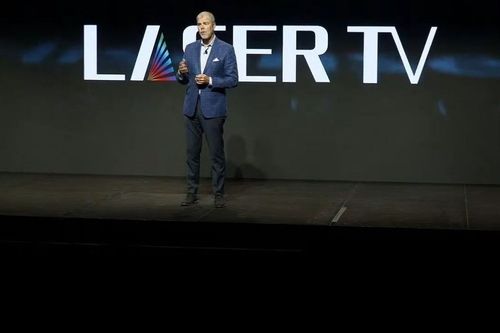Laser TV also supports the company’s energy efficiency goals

Hisense revealed an 8K-capable version of its supersized laser TV product at CES Tuesday, one company officials claim is the world’s first.
The company’s 8K variant of the Trichoma TV is powered by an 8K imaging chipset with embedded artificial intelligence that combs through every visual scene pixel by pixel to optimize the picture, and also hosts 20,000 mini LED partitions to enhance definition and contrast.
Not only will the new chip, slated to begin mass production in Q1 2022, be featured in the next Hisense Trichoma TVs, but Hisense also hopes to upsell to its broadcasting partners with the launch of 8K-embedded video production systems.
“Hisense has made laser TV into an entirely new category and one with the same [expectations] on performance as the traditional [categories,]” said Liu Xianrong, chief scientist at Hisense’s laser display division.
The company aims to capture further growth as American consumers upgrade to larger screen sizes ranging up to 130 inches for its laser, “cinema-quality” projectors.
David Vanderwaal, Hisense Americas vice president of marketing, shared some impressive sales numbers on ultra-large screen sizes during the company’s press conference.
The 65-inch and above screen category recorded 7% year-over-year growth across the industry in 2021. Hisense claims it exceeded this with U.S. sales trending 41% higher last year.
Hisense debuted its 100-inch Trichoma L9G laser TV product last year and the model boasts a tricolor laser projection system.
The product helped Hisense grow its laser TV sales by 300% year-on-year and scored the company a string of awards from both the Chinese press and Western cinema projection publications.
Hisense bets on laser for energy efficiency
Laser TV also supports Hisense’s energy efficiency goals, helping it squeeze more performance from models with lower electricity usage than LCD competitors.
While tricolor laser TVs faithfully recreate 8K color palettes, Hisense also believes they could replace a good share of existing LCD demand because they’re kinder to the environment when used for bigger screens.
The new 8K system is expected to debut with a 350-watt power supply but this could be reduced to 250 watts before next year, Xianrong said.
“Our world is looking for solutions to climate change, and the focus to achieving peak emissions,” he said. “We believe laser TV is the most energy-efficient technology and will become the most mainstream choice.”
The laser TV product announcement complements Hisense’s increasing focus on the smart home, with all of its latest TV offerings incorporating built-in voice activation through Google Assistant to control connected appliances.
Hisense also markets its smart appliances and is China’s biggest exporter of refrigerators having carved itself a foothold in foreign markets including central European countries like Serbia, Slovenia and the Czech Republic.
With regard to its smart appliance line, Hisense announced it was developing three exhibition centers for its Connect Life products in the U.S., Europe and China to showcase IoT household conveniences ranging from dishwashers to wine cabinets.
About the Author(s)
You May Also Like


.jpg?width=700&auto=webp&quality=80&disable=upscale)
.jpg?width=700&auto=webp&quality=80&disable=upscale)
.jpg?width=700&auto=webp&quality=80&disable=upscale)


.jpg?width=300&auto=webp&quality=80&disable=upscale)

.jpg?width=300&auto=webp&quality=80&disable=upscale)